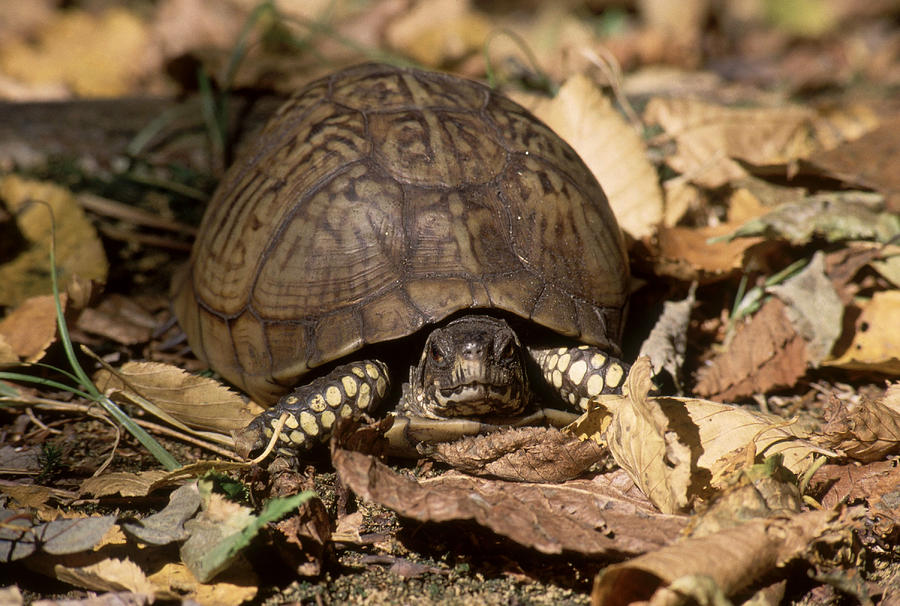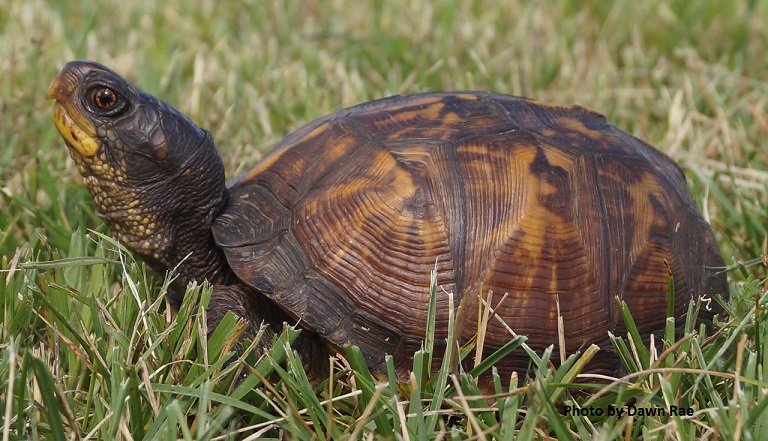

The subspecies Terrapene carolina triunguis is particularly distinctive as most males have a bright red head. There are six living subspecies of the common box turtle, each differing slightly in appearance, namely in the colour and patterning of the carapace, and the possession of either three or four toes on each hind foot. Males also differ from females by possessing shorter, stockier and more curved claws on their hind feet, and longer and thicker tails. The majority of adult male common box turtles have red irises, while those of the female are yellowish-brown. The common box turtle has a small to moderately sized head and a distinctive hooked upper jaw. The plastron is dark brown and may be uniformly coloured, or show darker blotches or smudges.

The carapace is brown, often adorned with a variable pattern of orange or yellow lines, spots, bars or blotches. The common box turtle ( Terrapene carolina) gets its common name from the structure of its shell which consists of a high domed carapace (upper shell), and large, hinged plastron (lower shell) which allows the turtle to close the shell, sealing its vulnerable head and limbs safely within an impregnable box. The hinges of the box turtle's lower shell Parentheses around the name of an authority indicate that he originally described the subspecies in a genus other than Terrapene. The other five subspecies were first classified during the 19th century. The eastern box turtle subspecies was the one recognized by Linnaeus. It is the type species for the genus Terrapene and has more subspecies than the other three species within that genus. Terrapene carolina was first described by Carl Linnaeus in his landmark 1758 10th edition of Systema Naturae. carolina in North Carolina and Tennessee and T. Three states have chosen subspecies of the common box turtle as their official state reptile: T. The species is classified as vulnerable to threats to its survival by the IUCN Red List. Turtles in the northern part of their range hibernate over the winter.Ĭommon box turtle numbers are declining because of habitat loss, roadkill, and capture for the pet trade. The females lay their eggs in the summer.

The turtle is primarily terrestrial and eats a wide variety of plants and animals. The box turtle has a distinctive hinged lowered shell (the box) that allows it to completely enclose itself. It is found throughout the Eastern United States and Mexico. Hatchlings are well-developed at birth and reach reproductive maturity when they are 5 years old.The common box turtle ( Terrapene carolina) is a species of box turtle with six existing subspecies. Incubation depends on temperature but averages 50 to 70 days. A female can lay anywhere from 1 to 5 clutches of about 1 to 9 eggs in a single year, or even delay laying her clutch if resources are scarce. Nests are then concealed with grass, leaves, or soil. Eggs are generally deposited shortly after the digging phase, and each egg is deployed into a particular position.

With the help of their hind feet females dig a shallow nest in loose soil. Temperature affects the sex of offspring, developmental rate, and possibly fitness. After mating the female finds an appropriate nesting site. Eastern box turtles can breed at any point throughout the late spring, summer, and early fall months, but egg-laying is most likely to occur in May and June when rain is frequent. It is known that Eastern box turtles don't form pair-bonds which means that they have either a polygynous (one male and multiple females) or polygynandrous (promiscuous) (both sexes have multiple partners) mating system.


 0 kommentar(er)
0 kommentar(er)
